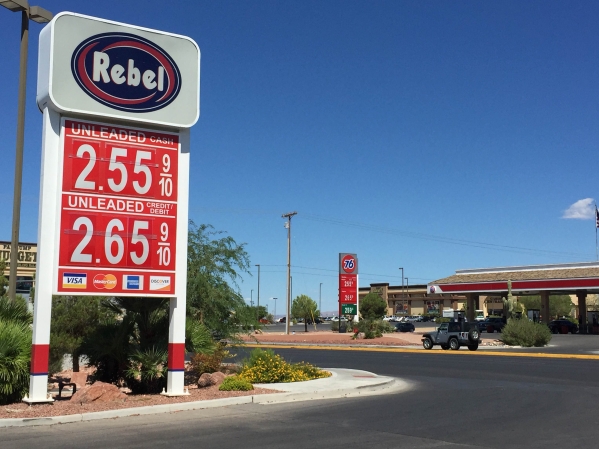Lower gasoline prices likely by late fall
Southern Nevada imports a lot from California.
We can count on the Golden State for tourists, relocating residents, expanding businesses — and stubbornly high gasoline prices.
Thanks to our key feeder market to the west, the Las Vegas Valley has missed out on the nation's big falloff in fuel costs. Regional demand has surged even as the California oil refineries that fill local gasoline tanks have wrestled with production problems. That means California faces a record gap between its average fuel price and the nation's.
We're feeling it, too.
"Las Vegas is kind of an island, separated from the rest of the country and served by California refineries," said Phil Flynn, an energy analyst with the Price Futures Group in the Chicago Board of Trade. "That has kept prices up in your area."
That's not to say local motorists have seen no relief.
Gasoline costs have ebbed measurably: The average price of a gallon of regular, unleaded gasoline in Las Vegas was $3.19 on Monday, according to travel club AAA. That was down 13.3 percent from $3.68 on the same day a year earlier.
Statewide, the dip was even more significant, with Monday's $3.13 average down 15.9 percent from $3.72 a year ago.
Those falloffs can't compare with the national drop, though. The U.S. average of $2.47 on Monday was 28.2 percent below $3.44 a year earlier.
Locally, Pahrump is ahead of the curve for Nevada and closer to the national average. The lowest per gallon cash price for regular unleaded was $2.55 at numerous stations around Pahrump.
If you're waiting for Las Vegas prices to dip into the mid-$2s, be patient. It will happen, observers said. But it will take a while.
Falloff not in lockstep
For starters, Nevada has to grapple with some of the same issues as the rest of the country.
Even the nationwide fuel-price drop hasn't kept pace with the slump in the price of crude oil.
Oil prices are down roughly 50 percent from an average of about $97 a barrel in August 2014. But crude oil makes up about half of what you pay at the pump. The rest includes refining and distribution expenses, which haven't fallen markedly, said Steve Brown, a professor in UNLV's Department of Economics and an energy economist previously with the Federal Reserve Bank of Dallas. So consumers shouldn't expect oil and gasoline prices to skid in lockstep.
Plus, retailers take higher profits when prices dip.
Brown has studied how fuel prices rise and fall with petroleum costs. He has found that gasoline prices start rising to match higher crude costs in as little as two weeks. On the flipside, it can take eight weeks or longer for what you pay at the pump to reflect diving oil prices.
That is because retailers can't raise prices too quickly, or consumers will slash the amount of gasoline they buy, Flynn said. That price resistance eats into profits when costs spike. So sellers recoup those lost profits by letting air out slowly when crude prices come down.
"Prices go up like rockets and fall like feathers," Flynn said.
Southern Nevada's gasoline market layers on additional barriers to lower fuel costs. Our retail market has fewer players owning more stores, and that hurts competitive pressures, Brown said.
What's more, the Clark County Commission agreed in 2013 to boost the local gasoline tax, which has risen 10 cents per gallon since January 2014, including a 3.4-cent jump in July. The higher taxes were designed to let the county take out $700 million in construction bonds to complete the Las Vegas Beltway and start work on Interstate 11 between Las Vegas and Phoenix.
Nevadans paid 52.25 cents per gallon in local state and federal gasoline taxes in July, compared with a federal average of 48.88 cents, according to the American Petroleum Institute.
Most importantly, though, the valley relies almost exclusively for its gasoline on a pipeline from California. As the Golden State's fuel markets go, so go ours.
A report from Reuters showed the gap between California fuel prices and the rest of the nation's average hit a high of $1.06 per gallon in late July, up from 43 cents at the start of 2015.
California's average price of $3.34 per gallon on Monday was 13 percent below its year-ago average of $3.85 — a decline percentage that almost exactly matches the valley's.
California has struggled to pare gasoline prices partly because it has been a rough year for the state's refineries, experts said. Most notably, a February explosion that shuttered an Exxon Mobil refinery in Torrance continues to hurt output. Company officials said on Aug. 13 that they hope to restart limited production at the plant, which produced 10 percent of California's gasoline output, sometime in September.
With production woes, California refineries are processing their lowest volumes of crude oil in a decade, Reuters said.
At the same time, gasoline demand in the West and the Rocky Mountain states was up about 4 percent year over year in early summer, said Tom Kloza, global head of energy analysis with the Oil Price Information Service in New Jersey.
"It's been a summer out West in which you could use the term 'driving season,' which had been antiquated since 2007," Kloza said.
Then there's the matter of the fuel those California refineries make. Their blends are pricier because they include additives to help California meet its own strict air-quality standards.
Staying married to California doesn't mean local fuel prices will stay permanently high.
In fact, local drivers may get substantial relief at the pump in just a few weeks.
Large drop predicted
Some parts of the country — particularly markets served by many refineries and fuel sources — have already seen a gallon of gasoline drop to as little as $1.85, Flynn said.
The valley's average probably won't decline that much, but it is set to keep falling.
Barring any major supply disruptions from big storms, geopolitical strife or additional refinery outages, forecasts call for ongoing price declines nationally, AAA spokeswoman Cynthia Harris said. Saudi Arabia has not announced production cutbacks for itself or OPEC, and Harris said Iranian oil is poised to "flood" the global market because of a multinational agreement that lifts economic sanctions in return for scalebacks of Iran's nuclear program.
Asked to peg the local average price for gasoline by 2015's end, Flynn, Kloza and Brown all cited a target of around $2.50 a gallon.
Demand will fall first, declining "appreciably" after Labor Day and sustaining its drop at least through January, Kloza said.
"It's a lumpy off-season. Just like you struggle to make enough in the summer, you struggle to get rid of it in the fall and winter," he said.
Cheaper refinery output will come into play in late fall as well.
By mid-September, the nation's refineries will start the changeover to less-expensive winter gasoline blends, which need fewer additives to prevent evaporation. California will switch as well — but not until late October. And that's when Las Vegas will finally start to feel the difference as well.
Said Kloza: "When you're chewing on your turkey in November, you'll be talking about how cheap gasoline is."
Maybe the lower prices in Las Vegas will drive the price down to close the $2.

















